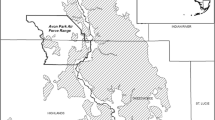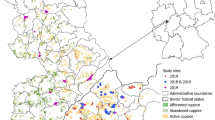Abstract
The distribution of resprouting and reseeding woody plants may be limited by the frequency of disturbances. Such species have a high probability of persisting in frequently and rarely disturbed habitats and may co-occur at intermediate disturbance frequencies. Nonetheless, resprouters and reseeders of the genus Hypericum co-occur in frequently burned pine savannas of southeastern North America. We predicted that these congeners would sort along a fire frequency gradient resulting from fine scale variation in topography and soil moisture. We examined habitat associations of a resprouter (H. microsepalum), facultative reseeder/resprouter (H. brachyphyllum), and reseeder (H. chapmanii) that occur along Northern Florida pine savanna ecoclines. We sampled five belt transects of 50 continuous 1 × 1 m2 plots for edaphic characteristics, fire spread, and densities of each species. Hypericum microsepalum was associated with upland, drier pine savannas where fires are frequent and typically burn uniformly across landscapes (2–3 year fire frequency). In contrast, H. brachyphyllum and H. chapmanii were associated with intermediate mesic areas where fires burn increasingly patchily downslope along ecoclines from upland flatwoods to lowland wet depressions (10–30 year fire frequency). Hypericum species of all life histories co-occur in intermediate areas where small changes in topography and edaphic characteristics generate a fire frequency gradient on a local scale. In pine savannas, fires vary from frequent to infrequent on a local within-landscape level as a function of elevation gradients. We conclude that the occurrence of such fire gradients along ecoclines should facilitate co-occurrence of plants with different life histories and thereby increase overall biodiversity.



Similar content being viewed by others
References
Abrahamson WG, Hartnett DC (1990) Pine flatwoods and dry prairies. In: Myers R, Ewel JW (eds) Ecosystems of Florida. University of Florida Press, Florida, pp 103–114
Bell TL (2001) Ecological response syndromes in the flora of Southwestern Western Australia: fire resprouters versus reseeders. Bot Rev 67:417–440
Bell TL, Ojeda F (1999) Underground starch storage in Erica species of the Cape Floristic Region—differences between seeders and resprouters. New Phytol 144:143–152
Bond WJ, Midgley JJ (2001) Ecology of sprouting in woody plants: the persistence niche. Trends Ecol Evol 16:45–51
Boughton EA, Quintana-Ascencio PF, Menges ES, Boughton RK (2006) Association of ecotones with relative elevation and fire in an upland Florida landscape. J Veg Sci 17:361–368
Bowen BJ, Pate JS (1993) The significance of root starch in post-fire shoot recovery of the resprouter Stirlingia latifolia R. Br. (Proteaceae). Ann Bot 72:7–16
Brewer JS, Cunningham AL, Moore TP, Brooks RM, Waldrup JL (2009) A six-year study of fire-related flowering cues and coexistence of two perennial grasses in a wet longleaf pine (Pinus palustris) savanna. Plant Ecol 200:141–154
Brown RB, Stone EL, Carlisle VW (1990) Soils. In: Myers R, Ewel JW (eds) Ecosystems of Florida. University of Florida Press, Florida, pp 35–69
Carr SC, Robertson KM, Peet RK (2010) A vegetation classification of fire-dependent pinelands of Florida. Castanea 75:153–189
Cary GJ, Morrison DA (1995) Effects of fire frequency on plant species composition of sandstone communities in the Sydney region: combinations of inter-fire intervals. Aust J Ecol 20:418–426
Clarke PJ (2002) Habitat insularity and fire response traits: evidence from a sclerophyll archipelago. Oecologia 132:582–591
Clarke PJ, Myerscough PJ, Skelton JN (1996) Plant coexistence in coastal heaths: between- and within-habitat effects of competition, disturbance and predation in the post-fire environment. Aust J Ecol 21:55–63
Clements FE (1936) Nature and structure of the climax. J Ecol 24:252–284
Clewell AF, Raymond C, Coultas CL, Dennis WM, Kelly JP (2009) Spatially narrow wet prairies. Castanea 74:146–159
Crandall RM (2011) The ecology of congeneric resprouters and reseeders (Hypericum spp.) along fire-frequented pine savanna ecoclines. Dissertation, Louisiana State University
Davis SD (1991) Lack of niche differentiation in adult shrubs implicates the importance of the regeneration niche. Trends Ecol Evol 6:272–274
Drewa PB, Platt WJ, Moser EB (2002) Community structure along elevation gradients in headwater regions of longleaf pine savannas. Plant Ecol 160:61–78
Drewa PB, Thaxton JM, Platt WJ (2006) Responses of root-crown bearing shrubs to differences in fire regimes in Pinus palustris (longleaf pine) savannas: exploring old-growth questions in second-growth systems. Appl Veg Sci 9:27–36
Enright NJ, Lamont BB (1989) Seed banks, fire seasons, safe sites and seedling recruitment in five co-occurring Banksia species. J Ecol 77:1111–1122
Enright NJ, Marsula R, Lamont BB, Wissel C (1998) The ecological significance of canopy seed storage in fire-prone environments: a model for non-sprouting shrubs. J Ecol 86:946–959
Enright NJ, Fontaine JB, Westcott VC, Lade JC, Miller BP (2011) Fire interval effects on persistence of resprouter species in Mediterranean-type shrublands. Plant Ecol 212:2071–2083
Eriksson O (1989) Seedling dynamics and life histories in clonal plants. Oikos 55:231–238
Galindez G, Biganzoli F, Ortega-Baes P, Scopel AL (2009) Fire responses of three co-occurring asteraceae shrubs in a temperate savanna in South America. Plant Ecol 202:149–158
Gilliam FS, Platt WJ, Peet RK (2006) Natural disturbances and the physiognomy of pine savannas: a phenomenological model. Appl Veg Sci 9:83–96
Godfrey RK (1988) Trees, shrubs, and woody vines of northern Florida and adjacent Georgia and Alabama. The University of Georgia Press, Georgia
Groeneveld J, Enright NJ, Lamont BB, Wissel C (2002) A spatial model of coexistence among three Banksia species along a topographic gradient in fire-prone shrublands. J Ecol 90:762–774
Harcombe PA, Glitzenstein JS, Knox RG, Orzell SL, Bridges EL (1993) Vegetation of the longleaf region of the west Gulf Coastal Plain. Proc Tall Timbers Fire Ecol Conf 18:83–104
Harms KE, Condit R, Hubbell SP, Roster RB (2001) Habitat associations of trees and shrubs in a 50-ha neotropical forest plot. J Ecol 89:947–959
Hawkes CV, Menges ES (1995) Density and seed production of a Florida endemic, Polygonella basiramia, in relation to time since fire and open sand. Am Midl Nat 133:138–148
Hiers JK, O’Brien JJ, Mitchell RJ, Grego JM, Loudermilk EL (2009) The wildland fuel cell concept: an approach to characterize fine-scale variation in fuels and fire in frequently burned longleaf pine forests. Int J Wildland Fire 18:315–325
Huffman JM (2006) Historical fire regimes in southeastern pine savannas. Dissertation, Louisiana State University
Iacona GD, Kirkman LK, Bruna EM (2010) Effects of resource availability on seedling recruitment in a fire-maintained savanna. Oecologia 163:171–180
Jacqmain EI, Jones RH, Mitchell RJ (1999) Influences of frequent cool-season burning across a soil moisture gradient on oak community structure in longleaf pine ecosystems. Am Midl Nat 141:85–100
Keeley JE, Zedler PH (1978) Reproduction of chaparral shrubs after fire: a comparison of sprouting and seeding strategies. Am Nat 99:142–161
Keeley JE, Fotheringham CJ, Baer-Keeley M (2006) Demographic patterns of postfire regeneration in Mediterranean-climate shrublands of California. Ecol Monogr 76:235–255
Keeley JE, Bond WJ, Bradstock RA, Pausas JG, Rundel PW (2012) Fire in mediterranean ecosystems. Cambridge University Press, New York
Kirkman LK, Mitchell RJ, Helton RC, Drew MB (2001) Productivity and species richness across an environmental gradient in a fire-dependent ecosystem. Am J Bot 88:2119–2128
Kirkman LK, Goebel PC, Palik BJ, West LT (2004) Predicting plant species diversity in a longleaf pine landscape. Ecoscience 11:80–93
Menges ES, Hawkes CV (1998) Interactive effects of fire and microhabitat on plants of Florida scrub. Ecol Appl 8:935–946
Menges ES, Kimmich J (1996) Microhabitat and time-since-fire: effects on demography of Eryngium cunefolium (Apiaceae), a Florida scrub endemic plant. Am J Bot 83:185–191
Olson MS, Platt WJ (1995) Effects of habitat and growing season fires on resprouting of shrubs in longleaf pine savannas. Vegetatio 119:101–118
Palmer MW, van der Maarel E (1995) Variance in species richness, species association, and niche limitation. Oikos 73:203–213
Pausas JG (2003) Resprouting vs seeding—a Mediterranean perspective. Oikos 94:193–194
Peet RK (2006) Ecological classification of longleaf pine woodlands. In: Jose S, Jokela EJ, Miller DL (eds) The longleaf pine ecosystem: ecology, silviculture, and restoration. Springer, New York, pp 51–93
Platt WJ (1999) Southeastern pine savannas. In: Anderson RC, Fralish J, Baskin J (eds) The savanna, barren, and rock outcrop communities of North America. Cambridge University Press, England, pp 23–51
Platt WJ, Schwartz MW (1990) Temperate hardwood forests. In: Myers R, Ewel JW (eds) Ecosystems of Florida. University of Florida Press, Florida, pp 194–229
Platt WJ, Evans GW, Rathbun SL (1988) The population dynamics of a long-lived conifer (Pinus palustris). Am Nat 131:491–525
Pyne SJ, Andrews PL, Laven RD (1996) Introduction to wildland fire. Wiley, New York
Reyes O, Casal M, Rego FC (2009) Resprouting ability of six Atlantic shrub species. Folia Geobot 44:19–29
Robson NKB (2003) Hypericum botany. In: Ernst E (ed) Hypericum: the genus Hypericum. Taylor and Francis, London, pp 1–22
Schmitz M, Platt W, DeCoster J (2002) Substrate heterogeneity and number of plant species in Everglades savannas (Florida, USA). Plant Ecol 160:137–148
Slocum MG, Platt WJ, Cooley HC (2003) Effects of differences in prescribed fire regimes on patchiness and intensity of fires in subtropical savannas of Everglades National Park, Florida. Restor Ecol 11:91–102
Slocum MG, Platt WJ, Beckage B, Orzell SL, Taylor W (2010) Accurate quantification of seasonal rainfall and associated climate-wildfire relationships. J Appl Meteorol 49:2559–2573
Soil Survey Staff, Natural Resources Conservation Service, United States Department of Agriculture. Web Soil Survey. http://websoilsurvey.nrcs.usda.gov/. Accessed 10 Mar 2010
Steele RGD, Torrie JJ (1980) Principles and procedures of statistics, a biometrical approach. McGraw-Hill Book, New York
Thaxton JM, Platt WJ (2006) Small-scale fuel variation alters fire intensity and shrub abundance in a pine savanna. Ecology 87:1331–1337
Verdù M (2000) Ecological and evolutionary differences between mediterranean seeders and resprouters. J Veg Sci 11:265–268
Vilà-Cabrera A, Saura-Mas S, Lloret F (2008) Effects of fire frequency on species composition in a mediterranean shrubland. Ecoscience 15:519–528
Virgona S, Vaughton G, Ramsey M (2006) Habitat segregation of Banksia shrubs at Gibraltar Range National Park. Proc Linn Soc NSW 127:39–47
Watson PJ, Bradstock RA, Morris C (2009) Fire frequency influences composition and structure of the shrub layer in an Australian subcoastal temperate grassy woodland. Austral Ecol 34:218–232
Whelan RJ (1995) The ecology of fire. Cambridge University Press, New York
Williams PR, Clarke PJ (1997) Habitat segregation by serotinous shrubs in heaths: post-fire emergence and seedling survival. Aust J Bot 45:31–39
Williams PR, Clarke PJ (2006) Fire history and soil gradients generate floristic patterns in mountain sedgelands and wet heaths of Gibraltar Range National Park. Proc Linn Soc NSW 127:27–38
Wooller SJ, Wooller RD, Brown KL (2002) Regeneration by three species of Banksia on the south coast of Western Australia in relation to fire interval. Aust J Bot 50:311–317
Acknowledgments
The authors thank Jean Huffman and the staff of the St. Joe Bay State Buffer Preserve for assistance with field sampling and logistics. The Garden Club of America, Louisiana Department of Wildlife and Fisheries, Friends of the St. Joe Bay State Buffer Preserve, Avon Park Air Force Range (U.S. Department of Defense), and National Science Foundation (DEB 0950302, W.J. Platt, PI) provided funding and support.
Author information
Authors and Affiliations
Corresponding author
Rights and permissions
About this article
Cite this article
Crandall, R.M., Platt, W.J. Habitat and fire heterogeneity explain the co-occurrence of congeneric resprouter and reseeder Hypericum spp. along a Florida pine savanna ecocline. Plant Ecol 213, 1643–1654 (2012). https://doi.org/10.1007/s11258-012-0119-0
Received:
Accepted:
Published:
Issue Date:
DOI: https://doi.org/10.1007/s11258-012-0119-0




